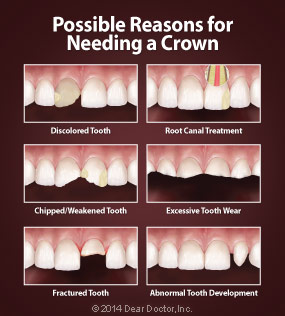Crowns & Bridgework
Traditional Techniques That Are Getting Better With Time

It has always been the goal of dentistry to try to preserve natural teeth. Today, people are keeping their teeth longer and it is expected that, finances permitting, decayed teeth will be restored rather than removed. However, when teeth are lost, they should be replaced in order to maintain good dental function (bite) and oral health. With dental implants becoming the gold standard for tooth replacement systems, more people are electing not to have bridgework — formerly the treatment of choice compared to removable dentures. Yet crowns and bridges may still be the best alternative for many people in certain situations.
A Tooth In Trouble
Almost all restorations of teeth are occasioned by tooth decay or dental trauma, both of which result in loss of healthy tooth structure. As the decay progresses, more and more of the healthy tooth is lost. The tooth as a whole becomes weaker, necessitating additional restorative (filling) material to replace it to keep it functional. If this happens repeatedly, the tooth may become too weak to support yet another filling. Then the dentist must decide what can be done to restore the tooth in order to make it stronger and healthier.
The remaining choice usually is a crown (cap). A crown is a restoration that covers the entire part of the tooth above the gum line, similar to placing a hat on someone’s head; hence the term cap. The crown is made to look as close to the original tooth (before it was damaged) as possible. The majority of crowns are made of tooth-colored ceramic materials, which are shaped to look and function just like normal, healthy teeth.
 |
| Possible Reasons for Needing a Crown Click to enlarge |
Crowns may vary in materials and design, depending on the location and type of tooth. For example, if the damaged tooth is highly visible in your smile, the most realistic-looking material will likely be used, like an all-porcelain ceramic material. Dental porcelains impart a translucent glasslike quality that resembles, and can be made indistinguishable from, tooth enamel. If the tooth is one that’s not so visible yet receives a major amount of biting force, strength might be the major concern. For example, a molar tooth in the back of the mouth may be more suited to a crown made of a precious metal like gold, a combination of porcelain fused to gold, or one of the new high-strength ceramics. The gold goes on the biting surface to resist the high biting force generated at molar teeth, while a porcelain facing covers the side of the tooth that may show in the smile. Your dentist will advise you as to the type that is best for you.
In order to restore a tooth, a dentist will first assess what needs to be done. Factors that are considered in deciding whether a crown is appropriate are:
- Has the tooth had so many fillings that another one is not possible?
- Has there been some trauma to the tooth, such as a fall or sports-related injury?
- Is there extensive tooth wear as a result of grinding, clenching or other habits?
- Has deep staining made the tooth appear too dark?
- Has abnormal development resulted in malformation or discoloration of a tooth or teeth?
- Does a damaged or diseased tooth that needed root canal therapy require a crown?
How Crowns Are Made
If a crown is your best option, your dentist will first prepare and reinforce the remaining tooth. This includes: removing decay; reinforcing it with bonding material when a lot of natural structure has been lost; and removing some tooth structure (although as little as possible) to create a shape that can successfully hold the crown.
An impression (mold) is then taken of the prepared tooth and your bite. Traditionally, this impression is sent to a dental lab, where a skilled technician custom-fabricates the crown. While your permanent crown is being made, you will receive a temporary one to keep the tooth comfortable and allow proper function. However, new digital technology is becoming available that allows a permanent crown to be milled right in the dental office while you wait.
When the crown is completed, the dentist will make any adjustments necessary to make it both comfortable and cosmetically appealing. At this time he or she will permanently cement or bond the crown to the prepared tooth. At the end of this procedure, the tooth will be comfortable, function just like a normal healthy tooth and will look great.
It is important to remember that even with its permanent crown, the tooth is still subject to tooth decay and must be cared for just as you would your own natural teeth — with daily brushing, preferably with fluoridated toothpaste, and flossing. It is also important to maintain your regular schedule of professional dental cleanings.


